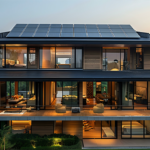Art Deco Architecture
Art Deco architecture emerged in the early 20th century, characterized by its bold geometric shapes, lavish ornamentation, and modern materials. It symbolized luxury, glamour, and technological progress, influencing architecture, design, and the decorative arts.

Key Characteristics of Art Deco
Art Deco architecture is known for its symmetry, streamlined forms, and decorative elements such as zigzags, sunbursts, and geometric patterns. It often incorporates materials like concrete, steel, and glass to create sleek, modern structures.
Influence of Art Deco Movements
Art Deco drew inspiration from diverse sources, including ancient civilizations, cubism, and the machine age. This eclectic blend resulted in buildings that exuded both elegance and functionality, reflecting the optimism of the early 20th century.
Iconic Examples of Art Deco Buildings
Notable examples of Art Deco architecture include the Chrysler Building in New York City, known for its distinctive spire and stainless steel ornamentation, and the Empire State Building, with its streamlined design and iconic setbacks.
Global Spread and Adaptation
Art Deco architecture spread globally, influencing urban landscapes from Miami’s South Beach to Mumbai’s Marine Drive. Its adaptability allowed it to flourish in various cultural contexts while maintaining its distinctive aesthetic principles.
Interior Design and Decorative Arts
Beyond architecture, Art Deco influenced interior design, furniture, and decorative arts. Opulent materials like lacquer, exotic woods, and inlaid metals characterized interiors, creating luxurious yet functional spaces.
Art Deco in Skyscraper Design
Art Deco played a significant role in the design of skyscrapers, emphasizing verticality through setbacks and decorative spires. These buildings became symbols of progress and modernity in cities around the world.
Preservation and Restoration Efforts
Efforts to preserve and restore Art Deco buildings have gained momentum, recognizing their architectural significance and cultural value. Preservation societies and heritage organizations work to maintain these landmarks for future generations.
Contemporary Applications and Revival
Art Deco continues to inspire contemporary architects and designers seeking to evoke the elegance and sophistication of the early 20th century. Its geometric motifs and luxurious materials are often reinterpreted in modern contexts.
Sustainability and Art Deco Principles
While originally associated with luxury and excess, Art Deco principles such as symmetry and efficient use of space align with contemporary sustainability goals. Adaptations focus on energy efficiency and environmentally friendly materials.
Challenges in Preservation
Preserving Art Deco buildings faces challenges such as urban development pressures, maintenance costs, and ensuring authenticity in restoration efforts. Balancing modern needs with historical preservation remains a delicate task.
Art Deco in Pop Culture and Media
Art Deco’s enduring appeal is evident in films, fashion, and graphic design, where its sleek lines and glamorous aesthetic continue to captivate audiences and inspire creative industries worldwide.
Conclusion: Art Deco’s Enduring Legacy
Art Deco architecture remains a vibrant testament to the creativity and optimism of the early 20th century. Its influence on modern design, from skyscrapers to interior decor, underscores its lasting impact on global architecture and culture.
Art Deco’s legacy continues to resonate with architects and designers drawn to its boldness, elegance, and celebration of modernity. By understanding its distinctive characteristics and historical context, we can appreciate how Art Deco continues to shape and inspire architectural innovation and aesthetic expression in the 21st century.



